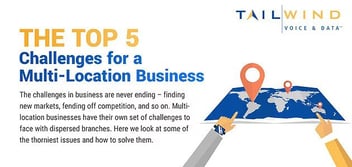Reliable internet connectivity is critical for businesses of all sizes – especially multi-location enterprises. Without connectivity, branch locations can’t deliver a consistent customer experience, communicate effectively between offices, or ensure employee productivity. But how can you be sure if broadband or fiber internet is the right choice for connectivity across your entire enterprise?
In this blog, we’ll explore the basics of broadband and fiber and break down the major differences to help you decide between these popular options.
Broadband vs. Fiber: The Basics
On a basic level, broadband and fiber networks connect users to the internet by transmitting data over cables. Broadband is built into existing phone and cable TV networks and transmits over copper phone lines or coaxial cable wire. Fiber transmits data via pulses of light sent over fiber cables, which are small, flexible glass strands.
Broadband vs. Fiber: The Differences
While broadband and fiber both offer several advantages, broadband is the clear winner for multi-location business internet. Here’s how these solutions stack up:
Cost
Fiber: Fiber is the newer, faster business internet solution, but its networks aren’t as widespread as broadband. As a result, fiber is often more expensive and time-consuming to provision.
Broadband: Broadband networks are built on top of existing telephone and TV infrastructure, so it’s a significantly more affordable option. Plus, carrier services from a trusted broadband aggregator like TailWind can help you increase your ROI by eliminating unused features and services, solving billing issues, and more.
Availability
Fiber: Fiber internet connections aren’t as widely available as their broadband counterparts, especially if you have branch offices in harder-to-reach areas.
Broadband: Most businesses already have broadband cable available in their offices since broadband networks form the backbone of telephone and TV networks.
Installation
Fiber: Installing fiber networks requires specialists and special equipment. Because these connections are provisioned for each customer, they tend to cost more and take longer to install than broadband.
Broadband: Installing broadband internet requires less time and resources because broadband networks are already widespread. As a result, broadband installation is a faster, more cost-effective option.
Streamline Your Multi-Location Business Internet Connectivity With Tailwind
Choosing between broadband and fiber for your multi-location business can have a big impact on your internet’s performance, cost, and reliability. If you’re lost in the crowd of business internet vendors and services, TailWind can help you find the best fit for your business.
Trust TailWind for:
- Right-fit services: Each of your locations has different bandwidth needs, so you shouldn’t have to settle for a one-size-fits-all solution. We offer the industry’s widest range of speeds to ensure each branch has what it needs to stay productive.
- Connectivity failover: We’ll help you avoid network outages by installing integrated secondary circuits and hardware to support your uptime requirements and provide peace of mind.
- Simplified management: Managing all the vendors, services, and speeds across a multi-location business can be challenging, but TailWind simplifies this chore as a broadband aggregator.
Visit this page to learn more about our broadband services – and get in touch with our experts today by filling out the contact form.


